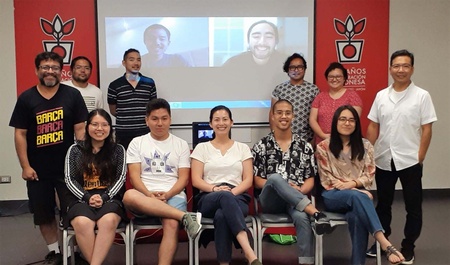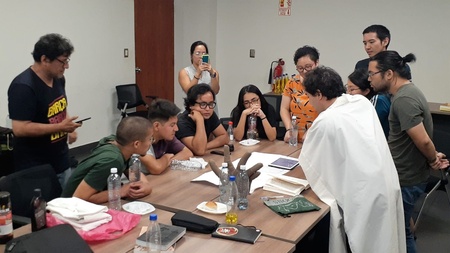2020 has been an especially hard year for artists and other cultural protagonists in Peru. To the closed theaters, canceled concerts and other spaces in an indeterminate suspension, is added a slow economic recovery that affects workers in all sectors and consumers, leading them to change their habits for digital dispersions feasible in voluntary isolation.
If the galleries were spaces for socialization, to meet the artists and listen to them, the Peruvian Japanese Cultural Center had gone a step further with the creation of the Nikkei Young Art Salon, a space for meeting and collaboration between novices, and not so novices. , artists of Japanese descent, summoned by the artist and cultural manager Haroldo Higa, to exhibit their works with an integrative view based on Nikkeidad.
This 2020 took the fourth group, accompanied by the curatorship of Juan Peralta, in full work, when the pandemic led them to carry out their workshops through virtual means, through which this 4th Young Art Salon was also launched Nikkei , which brings together the work of ten artists under the title “Alterities and geographies of Nikkeidad. Other stories from the community”, available on the website of the Peruvian Japanese Association (APJ).
Art and profession
Some common points can be glimpsed in the set of proposed works, which include photographic installations, sculptures, video animations, woodcuts and drawings. A common point is the professionalism of these young artists, who work as graphic designers, teachers and other complementary tasks that allow them to stay in permanent contact with art. Technology is another element present as a tool or essence of the creative work of many of these young people.

José Miguel Maesaka Takahesu , for example, has made a multimedia presentation through which he reinterprets a Shinto practice, senninbari (千人針), with the unique traces left by each person. “Regarding computer graphics, it is the tool that I feel I use best. I am interested in the level of finish I can reach and the creation process is quite flexible,” says José Miguel, who has specialized in this type of graphic design, after working as a 3D generalist in a production house.
“From the research we did during the curatorship process, I found several documents related to my family, and heard of several cases in which, due to the conflicts of the time, many others were lost or even had to be burned. Through my work I seek to represent that even though physical manifestations are lost, the legacy of these people lives on through us and the community they helped build,” adds Maesaka.
Life in video
In the installation Trans In Situ, the sculptor José Asato proposes a different look at Nikkeidad through the use of photographic archives with a superimposition of images that are part of his interest in research and experimentation in the audiovisual medium that is so common today. exploring various techniques such as photography, animation, installation and video art, through which he has begun his connection with the Peruvian Nikkei community with which he had almost had no contact.
“I realized that I was not as different as I thought and that the same unanswered questions I had about what it is to be or not to be Nikkei were everyone's questions, so I began to discover that Nikkei side that I had hidden for a long time,” says Asato, who made a personal exploration when collecting the family archive (documents and photographs) “playing a little with the photographic footprint itself, using transparencies, superimpositions, alterations... I feel that it has a lot to do with otherness and with the different degrees of purity that each generation has.”
For José, this fourth salon, which also includes other young Nikkei artists such as Ana Sofía Villanueva Imafuku, Diana Okuma Oshiro, Víctor Sakata Gonzáles and the fashion designer Kenichi Sato Chinen, has been an interesting space both for the collective process and for the fact being digital, multidisciplinary and “being able to receive criticism from various fields of art, I have also liked the exchange that we have had not only as artists but as people.”
Family and identity
Tammy Chion Fujishima is a sculptor by profession, but she has specialized in education. She confesses that she had forgotten her Nikkei ancestry for a long time, but that she has not forgotten her journalist great-grandfather who, like many, was sent to a concentration camp because of the war. “I believe that family history always influences the formation of the artist and his work, even if one does not want to.” In his case, the process to create a relief sculpture in pima and hydrophilic cotton was long.
“At the beginning I was clear that I had to touch on the topic of my Nikkeidad with subtlety; The story of my Nikkei ancestry was, and still is, full of gaps and I wanted to capture that absence through the material. For that reason I chose to work with cotton that, inevitably, will deteriorate over time until it is lost. Along the way, the sculpture became a kind of map where my Japanese, Peruvian, Chinese and Chilean ancestry mixes,” explains Chion.
Tammy loved being able to meet other young Nikkei artists who participated in this edition, among them the designer Tach Maeshiro Watanabe, the industrial designer Tetsu Tokumine Palomino (from Ica) and the painter Gian Bacilio Akamine Mateo. A lot of camaraderie was created between them, which she enjoyed in the midst of pregnancy with her second child. “I have lived my entire pregnancy during the pandemic. “I am an art teacher at a school, so I have done remote work until October when I gave birth,” she says.
Normality and virtuality
This year, the IV Nikkei Young Art Salon 2020 was presented virtually, with two video conversations where the artists shared their reflections on their artistic work. Family, personal and professional stories cannot be avoided in the midst of this new normal.
“It has been a difficult year, not being able to see family or friends has been hard. Although I spend a large part of the day in front of the computer, I am one of those who prefers to interact face to face with people,” says José Miguel Maesaka Takahesu, who continues with his personal projects. The same happens with José Asato, who says that he has been working in his workshop, producing new pieces, continuing his research on his Nikkeidad and thinking about doing his first individual exhibition, after this enriching experience.
“We have had very fun and memorable moments, especially in quarantine when we began to have more communication with each other. One of the topics that was discussed the most was the future of the project and how we were facing the crisis. We also sought to get to know each other a little more. We began to carry out activities via Zoom, from karaoke to blind portraits, which consists of drawing the person without seeing what you draw They were very fun moments that I was able to share not as with colleagues but as friends.”

On a work level, Tammy Chion says that the pandemic forced her to innovate in her teaching method. “It was like a great shock that took me out of my comfort zone and forced me to look for new means to continue teaching art despite the distance and lack of conventional materials,” says Tammy, who next year will continue focusing on her art. family and his work as a teacher.
© 2021 Javier Garcia Wong-Kit








